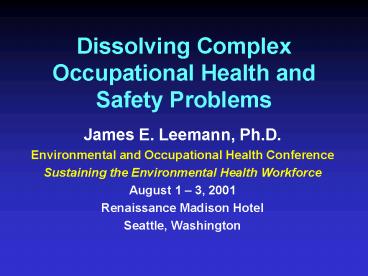Dissolving Complex Occupational Health and Safety Problems - PowerPoint PPT Presentation
1 / 20
Title:
Dissolving Complex Occupational Health and Safety Problems
Description:
Environmental and Occupational Health Conference. Sustaining the ... Absolution Ignoring the problem and hoping it will go away on its own accord. ... – PowerPoint PPT presentation
Number of Views:27
Avg rating:3.0/5.0
Title: Dissolving Complex Occupational Health and Safety Problems
1
Dissolving Complex Occupational Health and Safety
Problems
- James E. Leemann, Ph.D.
- Environmental and Occupational Health Conference
- Sustaining the Environmental Health Workforce
- August 1 3, 2001
- Renaissance Madison Hotel
- Seattle, Washington
2
Sustaining the Environmental Health Workforce
- Conference Objectives
- New opportunities skills to recruit, train, and
strengthen the environmental health workforce - Integration of Research and Practice into
curricula - Examination of environmental health competencies
3
Sustaining the Environmental Health Workforce
- Conference Objectives (contd)
- Issues surrounding the need for diversity
- Innovative techniques in curriculum development
4
New Opportunities Skills
- Occupational Health and Safety Management II
ENHS 724 - Using Systems Thinking to Dissolve Complex
Occupational Health and Safety Management
Problems Through - Interactive Planning
5
Systems Thinking
- A System is a whole that cannot be divided into
independent parts - And, therefore, when a System is taken apart it
losses all of its essential properties and so do
its parts - This is why a System cannot be understood by only
analyzing it.
6
System Analysis and Synthesis
- We are typically predisposed to taking systems
apart and treating the parts separately. This is - a consequence of analytic thinking.
- Analysis and thought are
- often treated as synonyms, but analysis is
- only one way of thinking synthesis is another.
7
System Analysis and Synthesis
- Analysis Focuses on structure and how things
work efficiently and how to repair it when it
stops working. Its product is Knowledge. - Synthesis Focuses on function and why things
operate as effectively as they do. Its product
is Understanding.
8
Dealing with Complex OHS Problems
- Absolution Ignoring the problem and hoping it
will go away on its own accord. - Resolution Doing something that yields an
outcome that is good enough. - Solution Doing something that yields or comes
as close as possible to the best possible
outcome, something that optimizes. - Dissolution Doing something to eliminate the
problem.
9
Dissolving Complex Occupational Health and Safety
Management Problems
- Dissolving problems involves the
- redesign of the entity that has the problem, or
its environment, in such a way as to eliminate
the problem and enable the system involved to do
better in the future than the best it can do
today, in a word, to idealize.
10
(No Transcript)
11
2. Integration of Research and Practice into
Curricula
- Occupational Health and Safety Management II
ENHS 724 - Group Research Practice Projects
- Teams range in size from 4 to 8 students
12
2. Integration of Research and Practice into
Curricula
- Occupational Health and Safety Management II
ENHS 724 - Group Research Practice Projects
- Implementing a PPE Program _at_ Silver Sutures
- Idealized Redesign of ABC Health Services
- Idealized Redesign of a Preactive OHS Mgnt.
System - Integrating the Systems Thinking Approach via
Standards-Based Management _at_ Multidiscipline
Laboratories - Aquarians to Antiquarians Knowledge Mngt. In
the Changing ENHS Workforce
13
3. Examination of Environmental Health
Competencies
- Core Competencies for the Effective
- Practice of Environmental Health
- Assessment Research, Data Analysis and
Interpretation, and Evaluation - Management Problem Solving, Economic and
Political Issues, Organizational Knowledge and
Behavior, Computer/Information Technology,
Reporting, Documentation and Record Keeping, and
Collaboration - Communication Education, Communication,
Conflict Resolution, and Marketing
14
3. Examination of Environmental Health
Competencies
- Occupational Health and Safety Management II
ENHS 724 - Course is designed to provoke the use of all 14
core competencies through the Group Project
report (40) and presentation (20) and the stiff
requirement (40) of class participation
15
4. Issues Surrounding the Need for Diversity
- Occupational Health and Safety Management II
ENHS 724 - Interactive Planning
- Key Premise Interactive Planning requires that
those who will be affected by or will affect the
system must participate in the planning process.
The process thrives on diversity of thought.
16
5. Innovative Techniques in Curriculum Development
- Tulane CAEPH of the Environmental Health Sciences
Department in the SPHTM was established in 1994
to - Fill a national need to link university faculty
and environmental, health and safety
professionals in industry and government to
promote the practice of environmental health.
17
5. Innovative Techniques in Curriculum Development
- Tulane CAEPH activities include
- Applying the public health approach to
environmental and occupational health - Developing communication strategies to
disseminate research and management information
18
5. Innovative Techniques in Curriculum Development
- Tulane CAEPH activities include (contd)
- Developing traditional and non-traditional
educational and training formats (including
distance learning technologies and computer-based
learning) - Incorporating epidemiological and risk-based
methods in environmental health science practice
19
Opening Thoughts
- Our Challenges
- To provide new opportunities and skills in
environmental health courses that stimulate
LEARNING in the context of todays realities. - To integrate research AND practice into
environmental health curricula. - To incorporate the application of environmental
health competencies into all courses so that
students understand the challenge of delivering
superior performance.
20
Opening Thoughts
- Our Challenges (contd)
- To present environmental health issues in a way
that practitioners recognize the importance of
diversity, both in thought and in the people who
are dealing with the issue. - To constantly seek new and innovative techniques
in curriculum development, both in delivery and
in currency.

